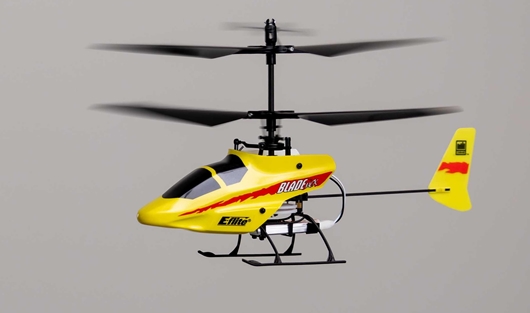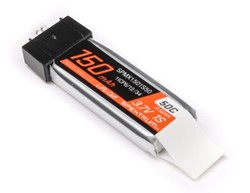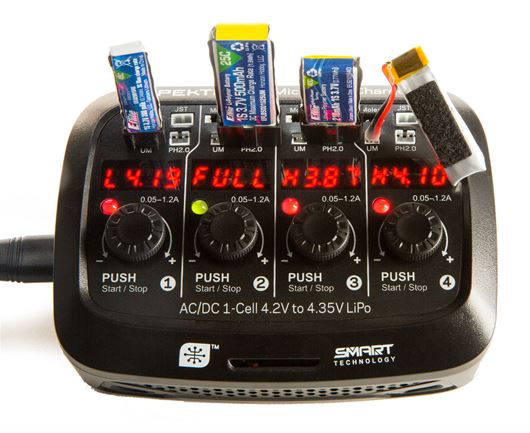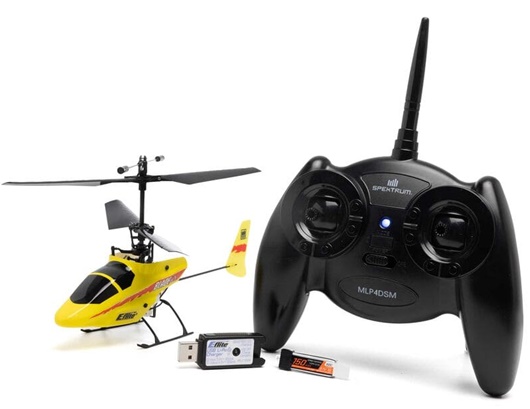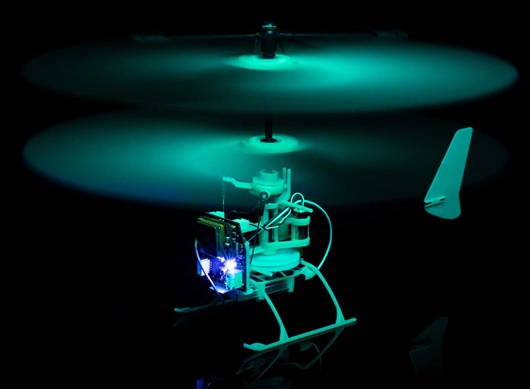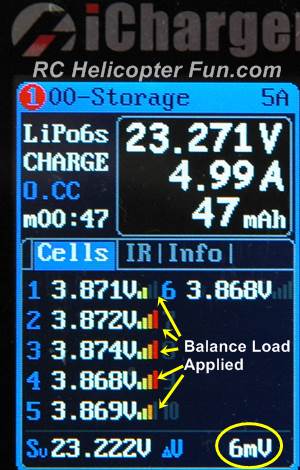Blade mCX Anniversary Special Edition
RC Helicopter Review
by John Salt - Updated May 2025
I consider the Blade mCX to be the most important and influential beginner RC helicopters of all time. Horizon Hobby must agree with this considering the release of the mCX Anniversary Special Edition in 2025.
This little coaxial heli has introduced so many people to the hobby in an inexpensive and more importantly, fun and successful way.
The mCX benefits from the inherent stability and efficiency that most micro coaxial RC helicopters have, but with better quality and durability despite the low cost.
The mCX is certainly not a piece of junk that ends up in the trash after several weeks of flying. Properly cared for, the mCX will offer years of flying fun.
My original 2009 mCX is still working well in 2025, with the "guts" inside a little Mars Ingenuity RC helicopter I built.
In the hundreds of e-mails I get from people who have or had Blade's mCX, no one has ever said anything truly bad about it. It's easy to see, easy to fly, has very good flight time, and the quality is better than pretty much anything else in this segment.
The light flying weight (1.1oz / 31g), combined with flexible parts and slower spinning coaxial rotors which don't release much energy during a crash, make it very hard to damage, even with some pretty aggressive crashes.
The best thing about the Blade mCX is the fact it appeals to such a wide range of RC enthusiasts. From the first timer who has never picked up the controls to a radio controlled device before, up to the advanced RC helicopter or fixed wing pilot wanting a fun way to keep flying indoors when the outside weather is less then ideal.
What Sets The Blade mCX Apart & Makes It So Special?
There are a number of reasons the mCX outshines other micro electric coaxial helicopters on the market, but it all starts with proper directional cyclic control.
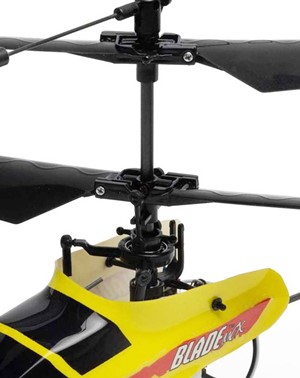 mCX's True Swashplate Cyclic Control
mCX's True Swashplate Cyclic ControlUnlike all of the toy grade, fixed pitch coaxial RC helicopters on the market that can only move forward and backward (poorly) with a weight shift or horizontal tail fan; the hobby grade Blade mCX uses a two axis swashplate; just like on more advanced RC collective pitch & full size helicopters.
This gives the 4 channel Blade mCX (forward, backward, left, right, combinations) directional control authority and precision that no simple 2 or 3 channel toy coaxial heli ever will.
Next up is the 5 in 1 control board.
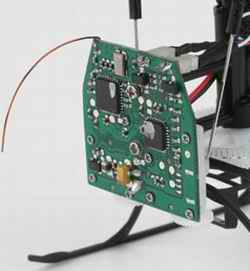 Original Blade mCX Control Board
Original Blade mCX Control BoardThe 5 in 1 board is the "brains" of the mCX and the only reason something this small can fly so well.
The board incorporates the receiver, the dual motor ESC mixers, the gyro and the two linear cyclic servos.
Never before had this much micro electronic sophistication been available so inexpensively when when it was first introduced to the market back in 2008.
The 5 in 1 controls the power to both coaxial rotor motors and does so with absolute precision while constantly calculating how much power to give each rotor to turn the heli left or right, increase or decrease altitude, or just hold a solid hover.
 mCX Anniversary Edition Improved 5-in-1 Control Board Offers Even Better Control & Stability
mCX Anniversary Edition Improved 5-in-1 Control Board Offers Even Better Control & StabilityIt may seem simple at first glance, but once you analyze all the physics that are going on during a flight being controlled by this little circuit board, you start to appreciate the complexity it offered back in the day.
A rate gyro is built into the 5 and 1 unit and works in seamless harmony with the motor mixer ESC to stop unwanted yaw with robotic precision.
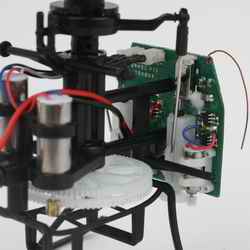 Linear Servos on Back of 5-in-One Save Space & Weight.
Linear Servos on Back of 5-in-One Save Space & Weight.The two linear servos that manipulate the swashplate are also mounted directly on the 5 in 1 board saving considerable weight & space over using individual micro servos.
Perhaps the most adaptable bit of circuitry crammed onto this tiny control board is the 4 channel receiver that uses DSMX protocol so you can fly the Blade mCX Anniversary Edition with any Spektrum or Multi-Protocol Radio/Transmitter using a popular and proven RF protocol.
As you grow in this hobby, this is something you'll really appreciate making it possible to control all your RC aircraft from one good radio saving time, money, and resources.
This unique system of universal control is called Bind & Fly (BNF) and in my opinion is one of the most beneficial side features that have come out of spread spectrum modulation.
Being a Horizon Hobby product, parts support both online and at many local RC hobby shops is very good.
Sum all that technical jargon up and you get the number one reason the Blade mCX outsold every other micro coaxial heli and has once again been made available:
IT'S JUST PLAIN FUN TO OWN & FLY!
Blade mCX Anniversary Special Edition Flight Characteristics
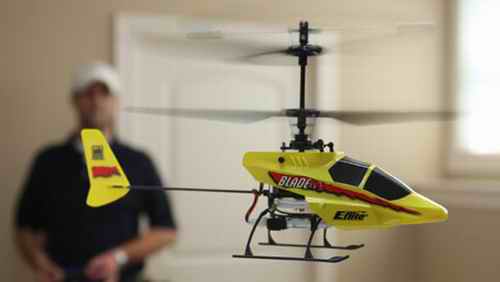 Flying The Blade mCX = FUN!
Flying The Blade mCX = FUN!As I mentioned this little heli is so stable.
I have never flown any other coaxial that's as stable as the mCX. It can hover in a solid spot for well over a minute with no pilot correction! The improved electronics on the 5-in-1 board of the Anniversary Special Edition make it even better with unwanted micro coaxial heli behaviors such as cyclic pendulum and toilet bowl largely eliminated.
The mCX spins (pirouettes) very quickly, equally right & left when given a command to do so or will pirouette turtle slow with a reduced rudder stick command. Lift control by way of rotor speed is very smooth and linear.
Paired with a Spektrum or Multi-Protocol computerized radio that allows you to smooth out the mid range of the throttle curve will further improve throttle resolution in the mid stick range for even better hover control / rotor speed resolution if you wish.
Cyclic control is predictable and gentle. Blade mCX's are certainly not going to win any air races; if you want that kind of speed in a micro sized beginner heli, you'll need to move up to more performance minded, single rotor fixed pitch models such as the C129 / Heli 101.
The mCX doesn't like any kind of wind. To put it more accurately - air movement. Yes, even the gentle air movement off a slowly turning ceiling fan, heat/AC duct, or convective air currents coming off a radiator or fireplace will throw it around.
This is very common with all micro coaxial helicopters, but since the mCX is one of the smallest & lightest, as you can appreciate, it doesn't take much air movement to toss it about.
Flight time out of the included single cell, 150 mAh 3.7 volt LiPo battery will vary between 7 and 10 minutes depending on how aggressively you fly and naturally how low you choose to discharge the battery.
8 minutes is a LiPo safe bet for general fun flying. The two coreless motors that power the rotors and the 5 in 1 are very efficient to produce those kind of flight times out of a tiny 150 mAh battery.
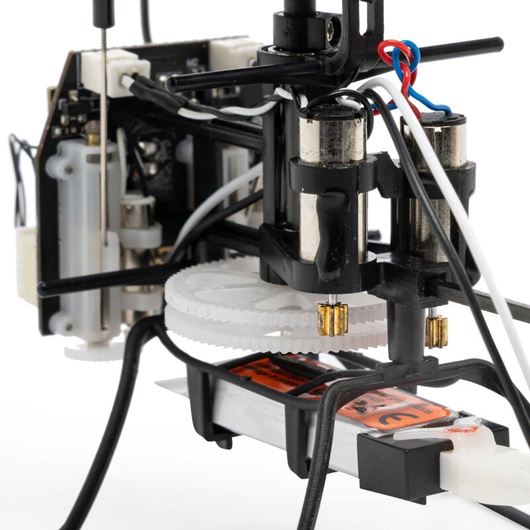 Two Brushed Coreless Main Motors Efficiently Power Each mCX Rotor
Two Brushed Coreless Main Motors Efficiently Power Each mCX RotorThe one must-have accessory everyone agrees on for the mCX (or any electric RC helicopter for that matter) is extra micro heli batteries.
Most micro 1S 150 mAh packs with Molex Picoblade plugs will work, but if you want to stick with Spektrum/Eflite packs, the Spektrum SPMX1501S50 and Eflite EFLB1501S45 micro LiPo's are recommended.
You can never have enough LiPo packs as it's very frustrating waiting for your single battery to charge between flights.
Speaking of charging, each 150 mAh pack takes about 45 minutes with the included USB charger from an 80% discharged state.
If you want to charge up to 4 micro LiPo packs to save even more time, it's hard to beat the Spektrum S44 Micro 4-port AC/DC 1S LiPo Charger.
Blade mCX Anniversary Special Edition Specifications
- Main Rotor Motor Type: Brushed Coreless (x2)
- Main Rotor Blade Length: 3.42" (87 mm)
- Main Rotor Diameter: 7.48" (190 mm)
- Main Rotor Head Type: Coaxial
- Power Type: Electric
- Heli Height: 4.8" (122 mm)
- Heli Length: 9.64" (245 mm)
- Heli Width: 1.42" (36 mm)
- Heli Weight Without Battery: 0.95 oz (27g) With 1S 150mAh Flight Battery: 1.09 oz (31g)
- Recommended Battery: 150mAh 1S 3.7V LiPo
- RF Protocol: Spektrum DSM2/X
- Swashplate Servo Type: Micro Linear (x2)
- Available in RTF & BNF Versions
- Skill Level: Beginner / Very Easy
The mCX Anniversary Edition comes in a ready to fly (RTF) package including: mCX helicopter, Spektrum MLP4DSM 4 Channel 2.4 GHz radio, 1S 150 mAh liPo and USB charger.
For those who already have a Spektrum or Multi-Protocol DSM2/X computerized radio, there is also a bind and fly (BNF) version that comes without the radio/transmitter.
Blade is even offering glow-in-the-dark parts to upgrade your mCX Anniversary or Original version for glowing flying fun. Not my cup of tea, but some will no doubt love this option.
An optional red canopy / tail fin are also being offered along with the full mCX2 body & LED light kit (BLH-2843). Don't overlook all the other aftermarket parts that have been made for the mCX over the years.
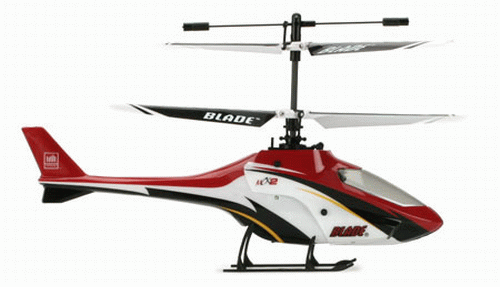 The Optional mCX2 Body Kit For The mCX
The Optional mCX2 Body Kit For The mCXFinal Thoughts
The Blade mCX was and still is best suited to the first time RC heli pilot or for those of us looking for indoor heli fun precision. It excels in tight spaces where more agile fixed pitch single rotor micro helicopters run out of room.
The mCX also offers a very workable platform for making your own small coaxial heli projects like I did with my original mCX.
 My Mars Ingenuity RC Helicopter Using Blade mCX Mechanics Inside
My Mars Ingenuity RC Helicopter Using Blade mCX Mechanics InsideIt's certainly time to get a newer Blade mCX!
Yes, I'm still taken back when I think of the amount of micro technology that was first introduced into it back in 2008, along with a good old, simple flybar.
Impressive mechanical stabilization which offers stability as good as any electronic stability system currently on the market today (in zero wind conditions of course). With better electronics, the new anniversary special edition improves on this already legendary stability by filtering out those aforementioned coaxial behaviors.
Thanks Horizon Hobby for brining back the micro coaxial heli legend!
